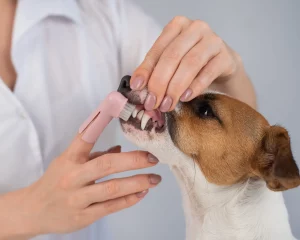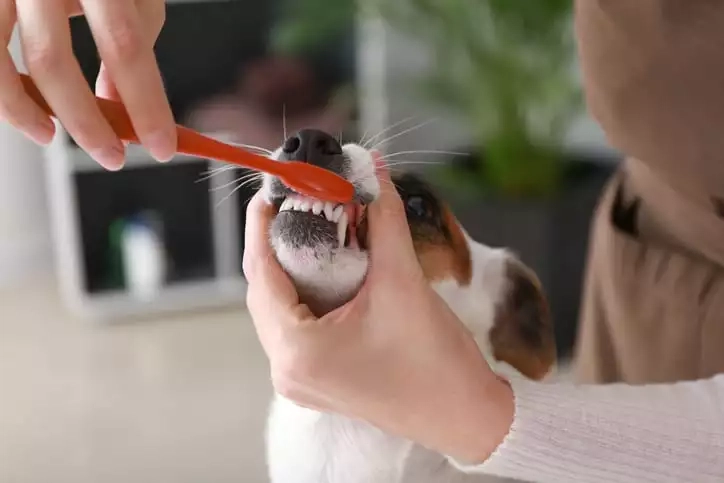Maintaining oral health is essential for pets, as it directly impacts their overall well-being. Regular teeth brushing at home can prevent serious dental conditions, enhance fresh breath, and reduce harmful bacteria. This simple yet important practice fosters a stronger bond between pet and owner, reflecting a commitment to the pet’s health. Understanding the proper techniques and tools for effective dental care reveals much more about how to guarantee a happier, healthier life for our furry companions.
Key Takeaways
- Regular brushing prevents periodontal disease, reducing pain and tooth loss, which enhances overall health and happiness for pets.
- Maintaining oral hygiene lowers the risk of bacteria entering the bloodstream, protecting essential organs and promoting longevity.
- Brushing fosters fresher breath, creating a more enjoyable bonding experience between pets and their owners.
- A consistent dental care routine showcases your commitment to your pet’s well-being, reinforcing trust and companionship.
- Gradual acclimatization to brushing reduces anxiety, making dental care a positive experience that contributes to your pet’s happiness.
The Importance of Oral Health for Pets
Maintaining ideal oral health is crucial for the overall well-being of pets. Just as in humans, poor dental hygiene can lead to serious health issues in animals, including gum disease and tooth loss. These conditions may cause pain, affect eating habits, and even lead to infections that impact essential organs. Pet owners play a critical role in ensuring their furry companions have healthy mouths. Learning how to brush pet teeth at home can greatly contribute to preventing dental problems. Regular brushing helps remove plaque buildup and reduces bad breath, fostering a happier and healthier life for pets. By prioritizing oral health, pet owners can nurture a deeper bond with their animals, enhancing their overall quality of life.
Understanding the Right Tools for Brushing
When it comes to brushing a pet’s teeth, selecting the right tools is essential for effective oral care. Pet owners should consider a soft-bristled toothbrush designed specifically for animals, which is gentle on gums yet effective in removing plaque. Finger brushes are also popular, allowing for greater control and comfort during brushing. Additionally, it is vital to use toothpaste formulated for pets, as human toothpaste can be harmful to them. Many pet-friendly options come in appealing flavors, enhancing the overall experience for both owner and pet. By equipping themselves with the right tools, pet owners can create a positive and rewarding routine that fosters a sense of belonging and commitment to their furry companions’ health.
Step-by-Step Guide on How to Brush Pet Teeth at Home
Brushing a pet’s teeth at home can greatly enhance their overall health, yet many owners may feel uncertain about where to begin. To start, gather the appropriate tools: a pet-specific toothbrush and toothpaste. Next, create a calm environment, allowing the pet to feel relaxed. Introduce the toothbrush gradually, letting them sniff and taste the toothpaste. Once they are comfortable, gently lift their lip and brush in circular motions, focusing on the outer surfaces of their teeth. Aim for two to three minutes of brushing, rewarding them with praise or treats afterward. Consistency is key; aim to brush their teeth several times a week. This simple routine fosters both dental health and a deeper bond between pet and owner.

Overcoming Common Challenges in Pet Dental Care
Although pet dental care is essential for overall health, many owners encounter challenges that can deter them from establishing an effective routine. Common issues include pets resisting brushing, owners feeling uncertain about proper techniques, and the lack of time in busy schedules. To navigate these obstacles, patience and gradual acclimatization are key. Introducing the toothbrush slowly and using pet-friendly toothpaste can help ease anxiety. Setting a regular schedule, even if brief, can make the process more manageable. Additionally, seeking guidance from veterinarians can boost owners’ confidence and guarantee they understand how to brush pet teeth at home effectively. By addressing these challenges, pet owners can foster a healthier dental routine that strengthens their bond with their furry companions.
Long-Term Benefits of Regular Teeth Brushing for Your Pet
Establishing a routine for brushing pets’ teeth can yield significant long-term benefits for their health and well-being. Regular tooth brushing helps prevent periodontal disease, a common issue that can lead to pain, tooth loss, and systemic health problems. By maintaining oral hygiene, pet owners reduce the risk of bacteria entering the bloodstream, which can affect essential organs such as the heart and liver. Additionally, routine dental care contributes to fresher breath and a more pleasant bonding experience between pets and their owners. This proactive approach fosters a sense of belonging, as caring for a pet’s dental health showcases commitment to their overall welfare. Ultimately, learning how to brush pet teeth at home can enhance the quality of life for beloved companions.
Frequently Asked Questions
How Often Should I Brush My Pet’s Teeth?
Experts recommend brushing a pet’s teeth at least two to three times a week. Regular dental care not only prevents plaque buildup but also promotes overall health, ensuring pets remain happy and vibrant companions.
Can I Use Human Toothpaste on My Pet?
Using human toothpaste on pets is not recommended, as it contains ingredients harmful to them, such as xylitol. Pet-specific toothpaste is formulated to be safe and effective, ensuring a healthy dental routine for beloved companions.
What Signs Indicate My Pet Needs a Dental Check-Up?
Signs indicating a pet needs a dental check-up include bad breath, difficulty eating, swollen gums, excessive drooling, and visible tartar buildup. Regular evaluations guarantee oral health, enhancing both the pet’s well-being and their owner’s peace of mind.
Is Dental Cleaning Necessary if I Brush Regularly?
Regular brushing can considerably reduce dental issues, but professional dental cleaning remains essential for removing stubborn plaque and tartar. Veterinary care guarantees ideal oral health, providing peace of mind for pet owners committed to their pets’ wellbeing.
How Can I Make Brushing More Enjoyable for My Pet?
To make brushing more enjoyable for a pet, owners can incorporate positive reinforcement, use flavored toothpaste, establish a routine, and gradually acclimate their pets to the process, ensuring a stress-free experience for everyone involved.
Conclusion
In summary, incorporating regular teeth brushing into a pet’s care routine is essential for their overall health and happiness. By preventing dental issues and promoting oral hygiene, pet owners can enhance their companion’s quality of life while fostering a deeper bond. With the right tools and techniques, the process can be manageable and rewarding. Ultimately, a commitment to dental care not only guarantees fresher breath but also contributes to the longevity and well-being of beloved pets.
You May Also Like To Read:






